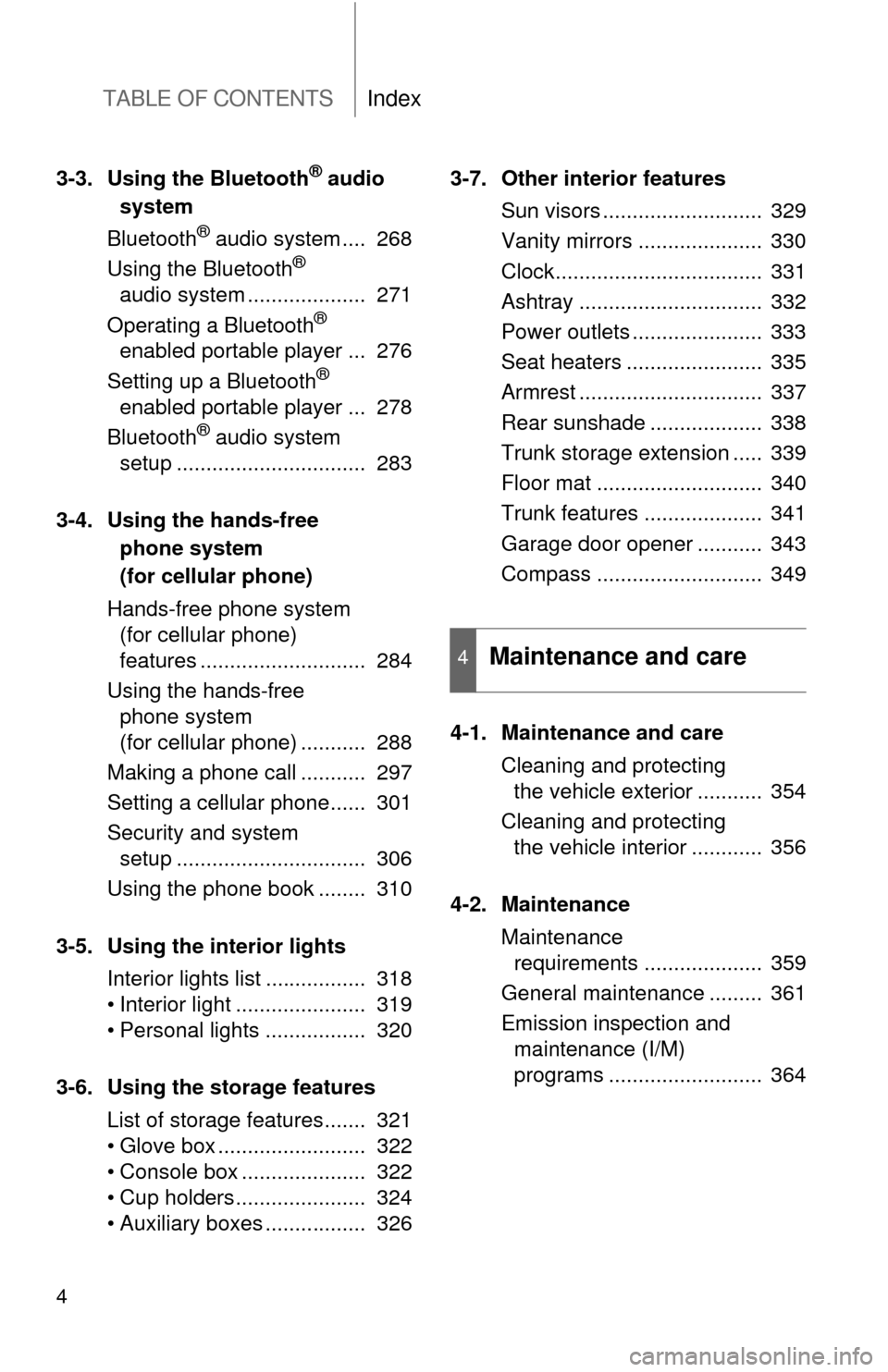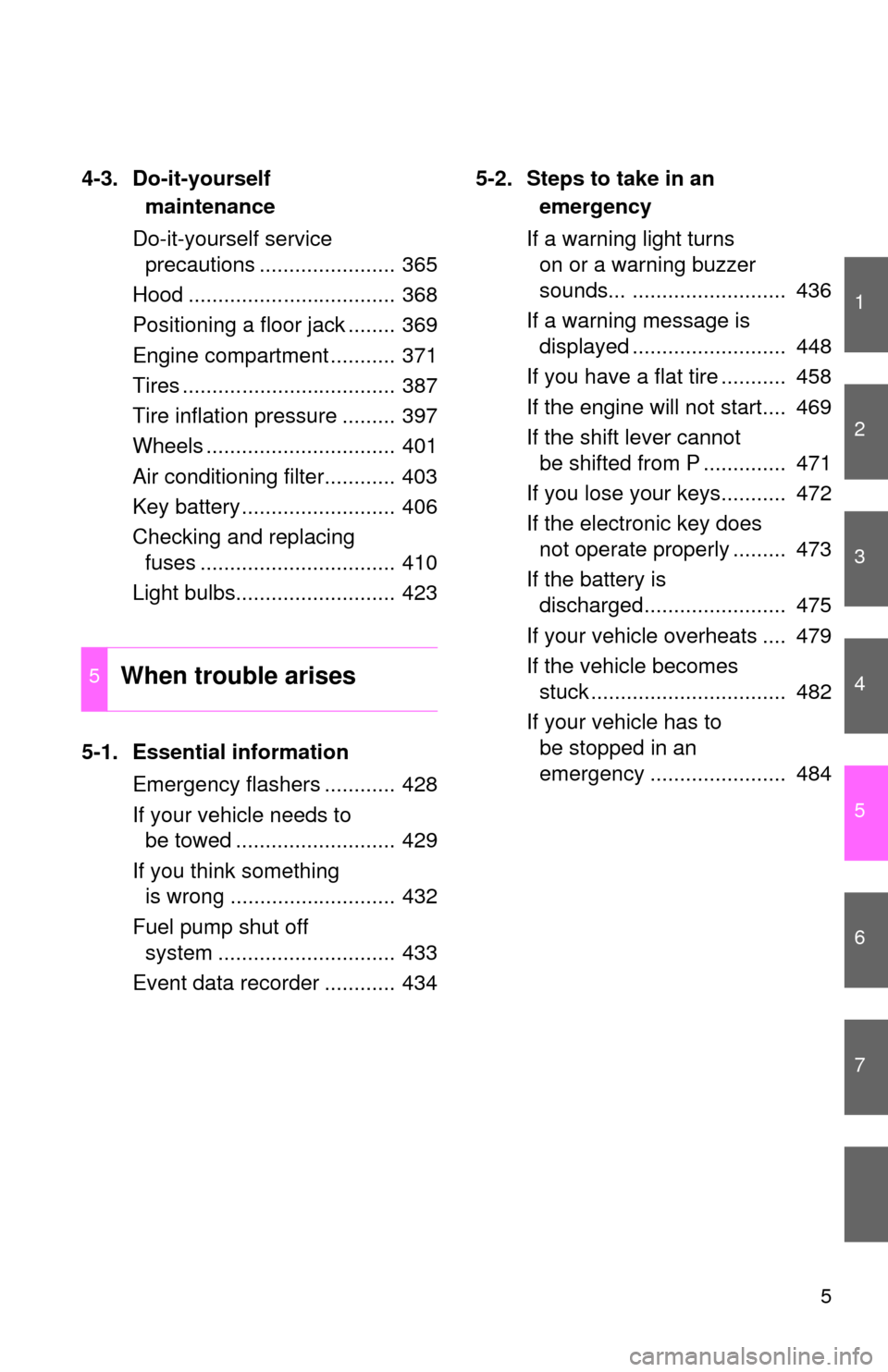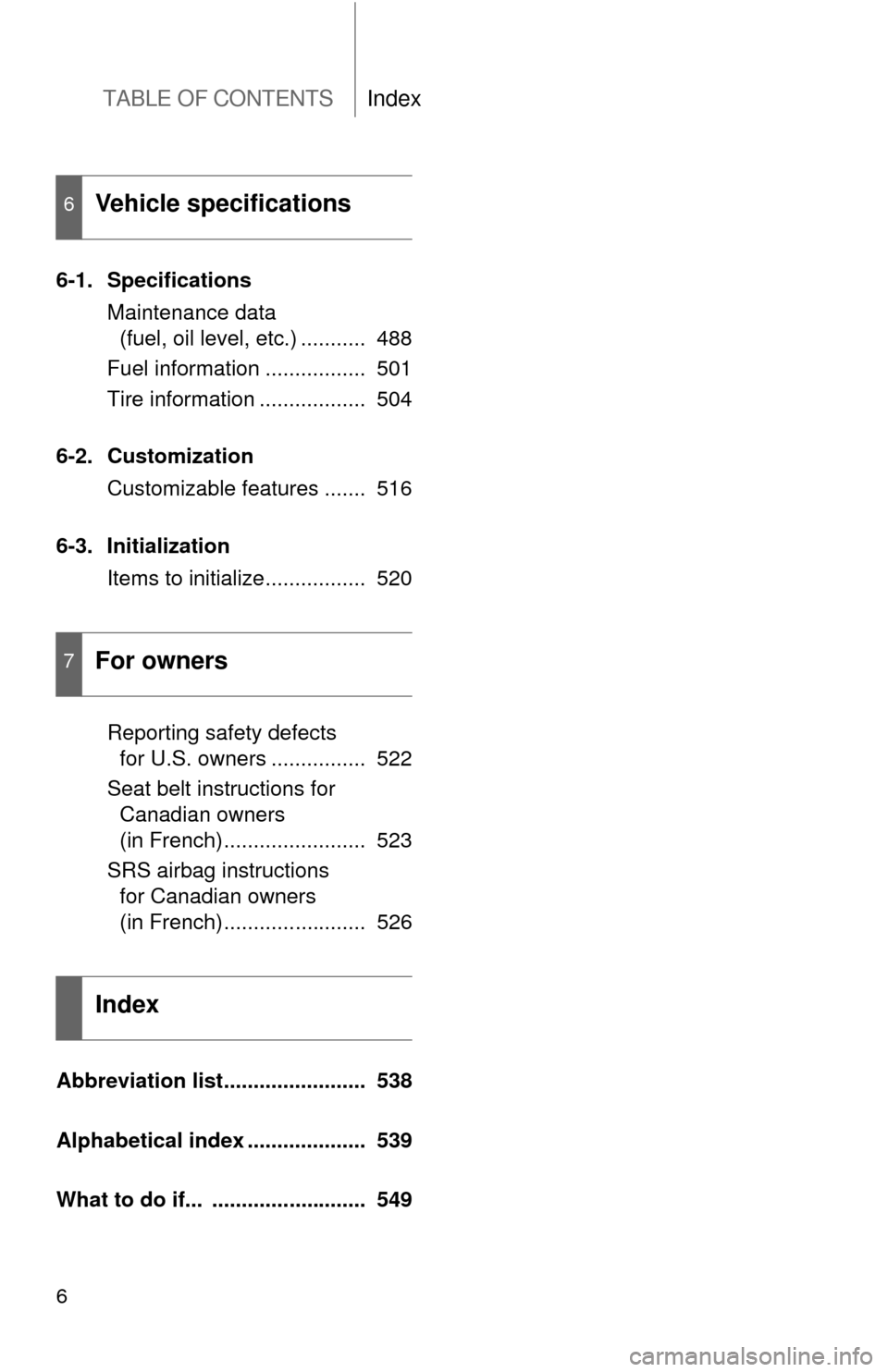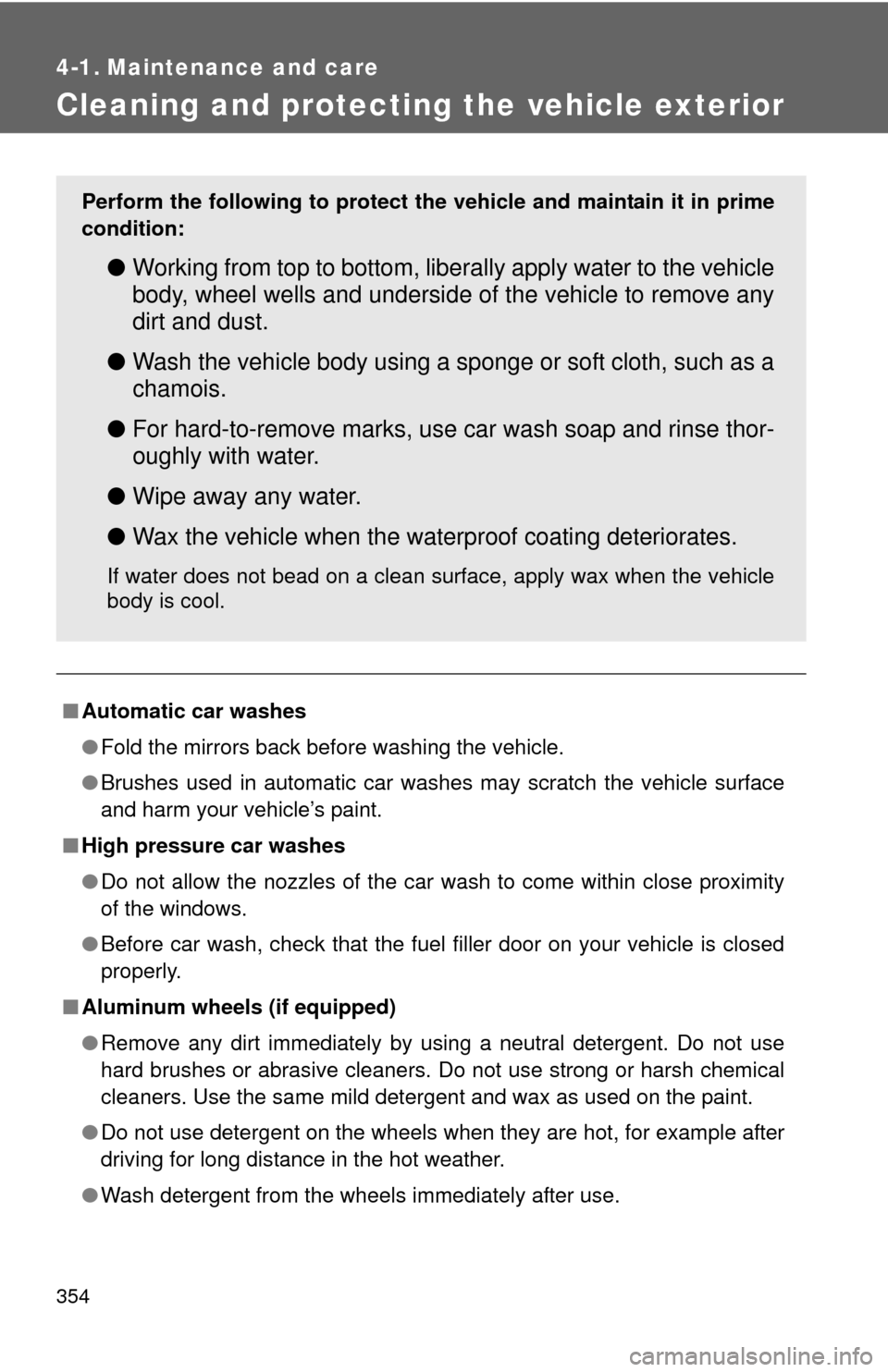maintenance TOYOTA CAMRY 2011 XV50 / 9.G Owners Manual
[x] Cancel search | Manufacturer: TOYOTA, Model Year: 2011, Model line: CAMRY, Model: TOYOTA CAMRY 2011 XV50 / 9.GPages: 554, PDF Size: 9.69 MB
Page 1 of 554

TABLE OF CONTENTS
1
1Before drivingAdjusting and operating features such as door locks,
mirrors, and steering column.
2When drivingDriving, stopping and safe-driving information.
3Interior fea-
turesAir conditioning and audio systems, as well as other in-
terior features for a comfortable driving experience.
4Maintenance
and careCleaning and protecting your vehicle, performing do-it-
yourself maintenance, and maintenance information.
5When trouble
arisesWhat to do if the vehicle needs to be towed, gets a flat
tire, or is involved in an accident.
6Vehicle
specificationsDetailed vehicle information.
7For ownersReporting safety defects for U.S. owners, and seat belt
and SRS airbag instructions for Canadian owners
IndexAlphabetical listing of information contained in this
manual.
Page 4 of 554

TABLE OF CONTENTSIndex
4
3-3. Using the Bluetooth® audio
system
Bluetooth
® audio system .... 268
Using the Bluetooth®
audio system .................... 271
Operating a Bluetooth
®
enabled portable player ... 276
Setting up a Bluetooth
®
enabled portable player ... 278
Bluetooth
® audio system
setup ................................ 283
3-4. Using the hands-free phone system
(for cellular phone)
Hands-free phone system (for cellular phone)
features ............................ 284
Using the hands-free phone system
(for cellular phone) ........... 288
Making a phone call ........... 297
Setting a cellular phone...... 301
Security and system setup ................................ 306
Using the phone book ........ 310
3-5. Using the interior lights Interior lights list ................. 318
• Interior light ...................... 319
• Personal lights ................. 320
3-6. Using the storage features List of storage features....... 321
• Glove box ......................... 322
• Console box ..................... 322
• Cup holders ...................... 324
• Auxiliary boxes ................. 326 3-7. Other interior features
Sun visors ........................... 329
Vanity mirrors ..................... 330
Clock................................... 331
Ashtray ............................... 332
Power outlets ...................... 333
Seat heaters ....................... 335
Armrest ............................... 337
Rear sunshade ................... 338
Trunk storage extension ..... 339
Floor mat ............................ 340
Trunk features .................... 341
Garage door opener ........... 343
Compass ............................ 349
4-1. Maintenance and care Cleaning and protecting the vehicle exterior ........... 354
Cleaning and protecting the vehicle interior ............ 356
4-2. Maintenance Maintenance requirements .................... 359
General maintenance ......... 361
Emission inspection and maintenance (I/M)
programs .......................... 364
4Maintenance and care
Page 5 of 554

1
2
3
4
5
6
7
5
4-3. Do-it-yourself maintenance
Do-it-yourself service precautions ....................... 365
Hood ................................... 368
Positioning a floor jack ........ 369
Engine compartment ........... 371
Tires .................................... 387
Tire inflation pressure ......... 397
Wheels ................................ 401
Air conditioning filter............ 403
Key battery .......................... 406
Checking and replacing fuses ................................. 410
Light bulbs........................... 423
5-1. Essential information Emergency flashers ............ 428
If your vehicle needs to be towed ........................... 429
If you think something is wrong ............................ 432
Fuel pump shut off system .............................. 433
Event data recorder ............ 434 5-2. Steps to take in an
emergency
If a warning light turns on or a warning buzzer
sounds... .......................... 436
If a warning message is displayed .......................... 448
If you have a flat tire ........... 458
If the engine will not start.... 469
If the shift lever cannot be shifted from P .............. 471
If you lose your keys........... 472
If the electronic key does not operate properly ......... 473
If the battery is discharged........................ 475
If your vehicle overheats .... 479
If the vehicle becomes stuck ................................. 482
If your vehicle has to be stopped in an
emergency ....................... 484
5When trouble arises
Page 6 of 554

TABLE OF CONTENTSIndex
6
6-1. SpecificationsMaintenance data (fuel, oil level, etc.) ........... 488
Fuel information ................. 501
Tire information .................. 504
6-2. Customization Customizable features ....... 516
6-3. Initialization Items to initialize................. 520
Reporting safety defects for U.S. owners ................ 522
Seat belt instructions for Canadian owners
(in French) ........................ 523
SRS airbag instructions for Canadian owners
(in French) ........................ 526
Abbreviation list........................ 538
Alphabetical index .................... 539
What to do if... .......................... 549
6Vehicle specifications
7For owners
Index
Page 83 of 554

83
1-6. Theft deterrent system
1
Before driving
■
System maintenance
The vehicle has a maintenance-free type engine immobilizer system.
■ Conditions that may cause the system to malfunction
● If the key is in contact with a metallic object
● If the key is in close proximity to or touching a key to the security system
(key with a built-in transponder chip) of another vehicle
■ Certifications for the engine immobilizer system
For vehicles sold in the U.S.A. (vehicles with smart key system)
FCC ID: NI4TMIMB-1 For vehicles sold in the U.S.A. (vehicles without smart key system)
FCC ID: MOZRI-20BTY
FCC ID: MOZRI-21BTY
NOTE:
This device complies with Part 15 of the FCC Rules. Operation is subject to
the following two conditions: (1) this device may not cause harmful interfer-
ence, and (2) this device must accept any interference received, including
interference that may cause undesired operation.
FCC WARNING:
Changes or modifications not expressly approved by the party responsible
for compliance could void the user's authority to operate the equipment. For vehicles sold in Canada
NOTE:
Operation is subject to the following two conditions: (1) this device may not
cause interference, and (2) this device must accept any interference, includ-
ing interference that may cause undesired operation of the device.
Page 86 of 554

86 1-6. Theft deterrent system
■System maintenance
The vehicle has a maintenance-free type alarm system.
■ Items to check before locking the vehicle
To prevent unexpected triggering of the alarm and vehicle theft, make sure
of the following.
●Nobody is in the vehicle.
● The windows and moon roof are closed before the alarm is set.
● No valuables or other personal items are left in the vehicle.
■ Triggering of the alarm
The alarm may be triggered in the following situations.
(Stopping the alarm deactivates the system.)
● Vehicles without smart key system: Turn the engine switch to
the “ACC” or “ON” position, or start the engine. (The alarm will
be deactivated or stopped after a few seconds.)
●A person inside the vehicle opens a
door, the trunk or hood.
● The battery is recharged or replaced
when the vehicle is locked.
Page 189 of 554

189
2-5. Driving information
2
When driving
■
Before towing
●Ensure that your vehicle’s tires are properly inflated. ( P. 397)
● Trailer tires should be inflated according to the trailer manufacturer's rec-
ommendation.
● All trailer lights must work in order to be legal.
● Confirm all lights work each time you connect them.
● Check that your vehicle remains level when a loaded or unloaded trailer
is hitched. Do not drive if the vehicle is not level, and check for improper
tongue load, overloading, worn suspension, or other possible causes.
● Make sure the trailer cargo is securely loaded.
● Check that your rear view mirrors c onform to any federal, state/provincial
or local regulations. If they do not, inst all rear view mirrors appropriate for
towing purposes.
■ Break-in schedule
Toyota recommends that you do not use a new vehicle or a vehicle with any
new power train components (engine, transmission, differential, wheel bear-
ings, etc.) to tow a trailer for the first 500 miles (800 km) of driving.
■ Maintenance
●If you tow a trailer, your vehicle will require more frequent maintenance
due to the additional load. (See “Scheduled Maintenance Guide” or
“Owner's Manual Supplement”.)
● Retighten the fixing bolts of the towing ball and bracket after approxi-
mately 600 miles (1000 km) of trailer towing.
Page 353 of 554

Maintenance and care4
353
4-1. Maintenance and careCleaning and protecting the vehicle exterior......... 354
Cleaning and protecting the vehicle interior.......... 356
4-2. Maintenance Maintenance requirements .................. 359
General maintenance....... 361
Emission inspection and maintenance (I/M)
programs........................ 364 4-3. Do-it-yourself
maintenance
Do-it-yourself service precautions .................... 365
Hood ................................ 368
Positioning a floor jack ..... 369
Engine compartment ........ 371
Tires ................................. 387
Tire inflation pressure ...... 397
Wheels ............................. 401
Air conditioning filter......... 403
Key battery ....................... 406
Checking and replacing fuses .............................. 410
Light bulbs........................ 423
Page 354 of 554

354
4-1. Maintenance and care
Cleaning and protecting the vehicle exterior
■Automatic car washes
●Fold the mirrors back before washing the vehicle.
● Brushes used in automatic car washes may scratch the vehicle surface
and harm your vehicle’s paint.
■ High pressure car washes
●Do not allow the nozzles of the car wash to come within close proximity
of the windows.
● Before car wash, check that the fuel filler door on your vehicle is closed
properly.
■ Aluminum wheels (if equipped)
●Remove any dirt immediately by using a neutral detergent. Do not use
hard brushes or abrasive cleaners. Do not use strong or harsh chemical
cleaners. Use the same mild detergent and wax as used on the paint.
● Do not use detergent on the wheels when they are hot, for example after
driving for long distance in the hot weather.
● Wash detergent from the wheels immediately after use.
Perform the following to protect the vehicle and maintain it in prime
condition:
● Working from top to bottom, liber ally apply water to the vehicle
body, wheel wells and underside of the vehicle to remove any
dirt and dust.
● Wash the vehicle body using a sponge or soft cloth, such as a
chamois.
● For hard-to-remove marks, use car wash soap and rinse thor-
oughly with water.
● Wipe away any water.
● Wax the vehicle when the waterproof coating deteriorates.
If water does not bead on a clean surface, apply wax when the vehicle
body is cool.
Page 355 of 554

355
4-1. Maintenance and care
4
Maintenance and care
■
Bumpers
Do not scrub with abrasive cleaners.
CAUTION
■Caution about the exhaust pipe
Exhaust gasses cause the exhaust pipe to become quite hot.
When washing the vehicle, be careful not to touch the pipe until it has cooled
sufficiently, as touching a hot exhaust pipe can cause burns.
NOTICE
■To prevent paint deterioration and corrosion on the body and compo-
nents (aluminum wheels etc.)
● Wash the vehicle immediately in the following cases:
• After driving near the sea coast
• After driving on salted roads
• If you see coal tar or tree sap on the paint surface
• If you see dead insects or insect droppings on the paint
• After driving in an area contaminated with soot, oily smoke, mine dust,
iron powder or chemical substances
• If the vehicle becomes heavily soiled in dust or mud
• If liquids such as benzene and gasoline are spilled on the paint surface
● If the paint is chipped or scratched, have it repaired immediately.
● To prevent the wheels from corroding, remove any dirt and store in a place
with low humidity when storing the wheels.
■ Cleaning the exterior lights
●Wash carefully. Do not use organic substances or scrub with a hard brush.
This may damage the surfaces of the lights.
● Do not apply wax on the surfaces of the lights.
Wax may cause damage to the lenses.